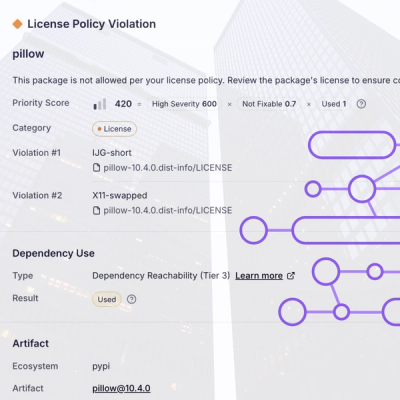
Research
/Security News
Critical Vulnerability in NestJS Devtools: Localhost RCE via Sandbox Escape
A flawed sandbox in @nestjs/devtools-integration lets attackers run code on your machine via CSRF, leading to full Remote Code Execution (RCE).
Standard HTTP interfaces for HTTP clients and servers in node.js and browsers

Standard, framework-agnostic HTTP interfaces for JavaScript servers and clients.
npm install servie --save
throwback Compose middleware functions into a single functionpopsicle HTTP request library for node.js and browsersservie-lambda Servie transport layer for AWS Lambdaservie-http Servie transport layer for node.js HTTPget-body General body parser for forms, JSON and textservie-cors CORS middleware for Servieservie-route Routing middleware for Servieservie-mount Mount Servie middleware on a path prefixservie-compat-http Mimic node.js HTTP using Servieservie-redirect Create response objects for redirectionservie-cookie-store API for managing client-side cookiesservie-errorhandler Standard error handler for transport layersservie-finalhandler Standard final handler for transport layershttp-errors Create HTTP errorsboom HTTP-friendly error objectsconsolidate Template renderingimport { Body, Request, Response, Headers, AbortController } from "servie";
Servie is a universal package, meaning node.js and browsers are supported without needing configuration. This means the primary endpoint requires some
domtypes in TypeScript. When in a node.js, or browser, only environment, prefer importingservie/dist/{node,browser}instead.
BodyBase HTTP class shared between
RequestandResponse.
new Body(body, headers);
Supported body types, depending on environment:
string | Buffer | ArrayBuffer | Readable | null | undefinedstring | ArrayBuffer | ReadableStream | null | undefinedbodyUsed Boolean whether the body is already consumedtext() Returns the body as a Promise<string>json() Returns the body with JSON.parse as Promise<any>arrayBuffer() Returns the body as a Promise<ArrayBuffer>clone() Clones an unconsumed bodydestroy() Consumes and destroys the bodyRequestHTTP class for modelling a
Request, extendsBody.
new Request(input [, init]);
A URL string or another Request instance to clone from.
method? HTTP request method.body? Any support body types.signal? A signal from an AbortController.headers? A map, list of tuples, or Header instance to initialize from.trailer? A promise resolve to a support header initialization types (above).url Requested url stringmethod Requested method stringsignal Signal event emitterheaders A Headers instancetrailer A Promise<Headers> instanceclone() Clones the request into a new instanceResponseHTTP class for modelling a
Response, extendsBody.
new Response([body [, init]]);
One of the support body types (above).
status? The numeric HTTP response status codestatusText? The HTTP response status textstatus The numeric HTTP response status codestatusText The HTTP response status textok Boolean indicates successful response (status between 200 and 299)headers A Headers instancetrailer A Promise<Headers> instanceclone() Clones the response into a new instanceHeadersMap representation of HTTP headers.
new Headers([init]);
Initialize headers from Iterable<HeaderTuple>, a HeadersObject or an existing Headers instance.
set(name: string, value: string | string[]): void Set a HTTP header by overriding case-insensitive headers of the same nameappend(name: string, value: string | string[]): void Append a HTTP headerget(name: string): string | undefined Retrieve a case-insensitive HTTP headergetAll(name: string): string[] Retrieve a list of matching case-insensitive HTTP headershas(name: string): boolean Check if a case-insensitive header is already setdelete(name: string): void Delete a case-insensitive headerasObject(): HeadersObject Return the lower-cased headers as a plain objectextend(obj: HeadersInit): this Extends the current headers with an objectkeys() Iterable of the available header namesvalues() Iterable of header valuesentries() Iterable of headers as [key, value]clear() Clears the headers instanceclone() Clones the Headers instanceAbortControllerSimple controller for aborting a
Requestinstance.
new AbortController();
signal A Signal instance to pass to a Requestabort() Used to abort any listening requests through the signalSignalTiny event emitter for communicating during a request.
aborted Boolean indicating whether the request is abortedon(type, fn) Attach an event listener to an event typeoff(type, fn) Remove an event listener from an event typeeach(fn) Attach an event listener for all eventsnone(fn) Remove a global event listeneremit(type, ...args) Emit an event to all listenersabort The request has been abortedrequestBytes Emitted on request progress with current bytesrequestEnded The request has endedrequestStarted The request has been startedresponseBytes Emitted on response progress with current bytesresponseEnded The response has endedresponseStarted The response has startedPlugins can emit new types of events.
If you're building the transports for Servie, there are some life cycle events you need to be aware of:
error event on signal for errorsabort event on signal to destroy the connectiontrailer promise and append to HTTP request or responseSignalEvents you can supportThis module is designed for ES2017 environments and published with TypeScript definitions on NPM.
Apache 2.0
FAQs
Standard HTTP interfaces for HTTP clients and servers in node.js and browsers
The npm package servie receives a total of 78,137 weekly downloads. As such, servie popularity was classified as popular.
We found that servie demonstrated a not healthy version release cadence and project activity because the last version was released a year ago. It has 1 open source maintainer collaborating on the project.
Did you know?

Socket for GitHub automatically highlights issues in each pull request and monitors the health of all your open source dependencies. Discover the contents of your packages and block harmful activity before you install or update your dependencies.

Research
/Security News
A flawed sandbox in @nestjs/devtools-integration lets attackers run code on your machine via CSRF, leading to full Remote Code Execution (RCE).

Product
Customize license detection with Socket’s new license overlays: gain control, reduce noise, and handle edge cases with precision.

Product
Socket now supports Rust and Cargo, offering package search for all users and experimental SBOM generation for enterprise projects.